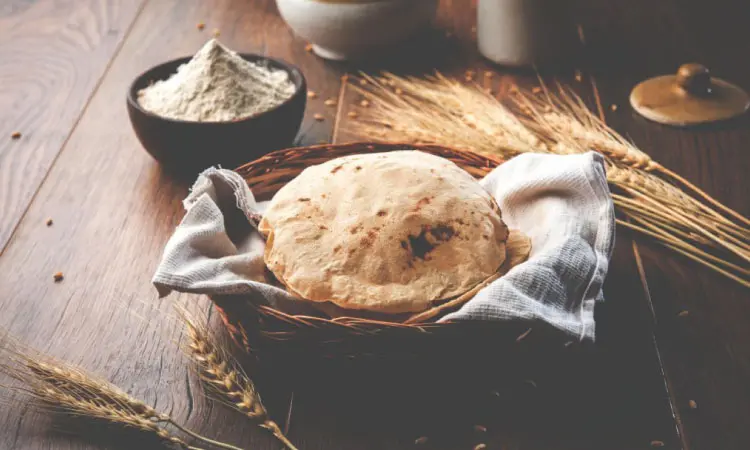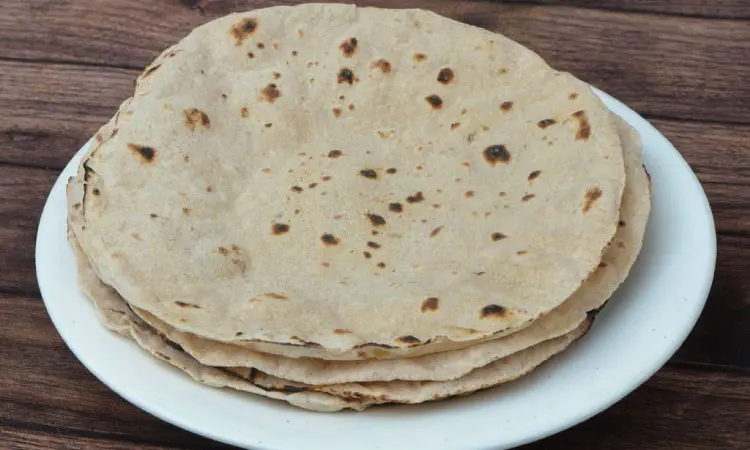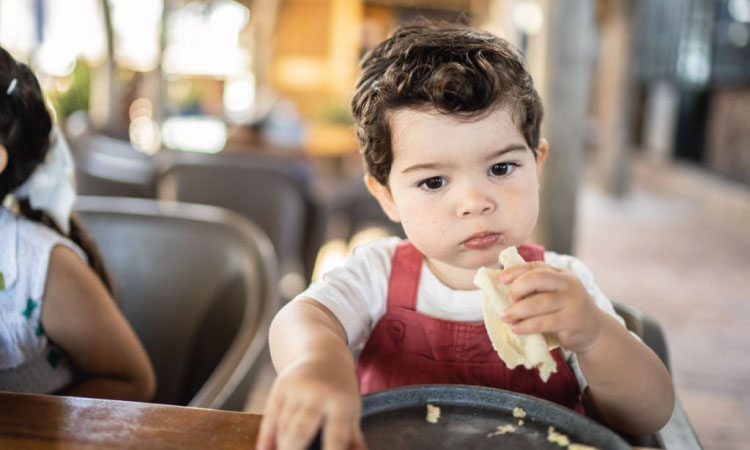When a child transits to solids, right after Annaprashan– first rice eating ceremony, the worry of a mom starts increasing with regards to what to offer to the kid that is both healthy and safe for consumption. Changing the diet according to the growth of the child to meet their nutritional requirement is essential. If you live in a family that consumes Chapati/Roti, you may have many doubts about offering Roti for babies.
Since wheat is the most commonly available cereal it has a lot of demand as well as an abundance of health benefits. It is one of the most wholesome food items too. Many people recommend consuming this as it is extremely beneficial for healthy living.
Right from multigrain Roti for babies to wheat and various options, here’s what you need to know about giving Chapati/Roti to babies.
What Is Roti?
Roti or Chapati is primarily made of wholewheat and is a flatbread eaten with curries and other popular Indian dishes. They are round in shape and are made with flour known as ‘Atta‘ or with multi-grains for nutritional purposes. Roti is a staple food across the Indian subcontinent and has a long history with countries like India.
Nowadays, Roti can be found in countries all around the world, especially in places with large Indian or Pakistani immigrant populations. The main ingredients of Roti are whole wheat and Atta flour. You will need a little water to make the flour into a dough, and it requires no seasoning, especially when you plan for Roti for babies.
While Roti/Chapati may seem to be simple in terms of ingredients, its making requires some technical know-how. To make it taste best, you can add Ghee, and clarified butter that is traditionally brushed while offering Chapati for babies.
Related Reading: 10 Most Important Nutrients For Children
Nutritional Profile Of Roti
Rotis are prepared with unleavened flour and are packed to the brim with nutrients. Roti contains Vitamins B, E, and minerals like copper, zinc, iodine, manganese, silicon, potassium, calcium, and other mineral salts.
Whole wheat in Rotis is also an excellent source of whole grain, and it is seen that 3 servings a day can help reduce the risk of heart disease so that you can lead a healthier, happier life.
While Chapati is not all about carbs, it also contains various micro-nutrients, protein, and fiber, which are necessary for our body. It has soluble fiber that cleanses plaque from blood vessels and prevents constipation. It contains no fat unless smothered with ghee or butter.
According to a source, below are the nutritional facts for 1 medium sized Roti (40 grams):
- Calories from Fat 33
- Calories 120
- Total Fat 3.7g grams 6%
- Saturated Fat 1.3g grams 7%
- Polyunsaturated Fat 0.3g grams
- Monounsaturated Fat 0.8g grams
- Sodium 119 mg milligrams 5%
- Potassium 78 mg milligrams 2%
- Total Carbohydrates 18g grams 6%
- Dietary Fiber 3.9g grams 16%
- Sugars 1.2g grams
- Protein 3.1g
- Calcium 1.10% of daily value
- Iron 4.90% of daily value
Related Reading: 15 Common Foods That Can Be Unsafe For Babies
Health Benefits Of Rotis For Babies
Though Roti for babies goes by the names of Chapati and Phulka, the difference in their names does not change its nutritious properties. It comes with plenty of complex carbohydrates to give sustained energy along with proteins to help build and maintain muscles.
Nonetheless Roti is considered the healthiest food, not all Rotis are healthy, especially those made from Maida. Maida is refined flour which gives the same effect on the body as sugar – fattening.
However, this must not stop you from offering Chapati for babies as there are various healthy alternatives for this such as multigrain Roti for babies. You can also consider options such as chickpea flour instead of Maida. To make it even healthier, you can add chopped cooked vegetables to the dough – like spinach, carrot, etc.
Listed below are the health benefits of Roti for babies that will make you include it as a part of your baby’s diet daily.
1. Packed with energy
One of the best and the top benefits of Roti for babies is that it is a rich source of energy. Since Rotis are loaded with carbohydrates it gives the baby the ample amounts of energy required for them throughout the day. It will also keep the baby full for longer hours making you relax a bit about their hunger.
2. Good for the baby’s skin
Since Roti contains zinc and other minerals that help to keep the baby’s skin healthy, you can consider offering Chapati for babies. For younger babies, you can offer Chapati soaked in milk for babies. The property of zinc is it helps to fight bacteria and viruses. Another benefit of Roti for babies is that it gives a natural glow to your baby’s skin.
Related Reading: 10 Best Baby Products For Your Baby’s Sensitive Skin
3. Packed with nutrients
Roti is prepared from wheat flour that is not processed with any agents like yeast thus making Roti for babies a healthy food option. Nutrients such as zinc, potassium, magnesium, silicon, and other mineral salts make it a perfect choice for your kid. Since these are very essential for a healthy body, you may offer this powerhouse of nutrients.
4. Helps in digestion

Since Rotis are a good source of fiber, it helps in improving the digestion of your baby and enriches their gut health. If your child suffers from constipation, you may try including this as a part of their diet.
5. Rich in iron
Wheat Chapati for babies comes with a good source of iron that helps in maintaining the blood levels of your little one, preventing them from becoming anemic. Hence, make it a part of your little one’s daily meal to maintain normal hemoglobin levels.
6. Rich in protein
Wheat Chapati for babies comes with a good source of protein. Adding curd, paneer, or incorporating protein-rich gravy to the wheat dough can increase the protein levels of your child. Wheat Chapati for babies is a good substitute for rice as they have good amounts of protein as well as healthy carbs.
7. Good for bone development
Phosphorus is an important nutrient and is referred to as the building block of calcium absorption in your bones. With the help of zinc content in chapati, other minerals get absorbed, especially phosphorus. Your baby’s bones could be healthy if they consume high phosphorus content food1.
Tips For Preparing Rotis For Babies
Being a staple food and a common fish in every Indian kitchen, Chapati — the Indian flat bread is enjoyed with various curries and side dishes. However, when it comes to making soft and puffed Chapatis, it is still a struggle for many.
The dough for Chapatis is typically kneaded with water, salt, and wheat flour. However, if the moisture content in the dough or the rolled Chapatis is lost during or after cooking, they will end up as rubbery or crusty Chapatis which can’t be offered for babies.
While offering Chapatis for babies, you must ensure that they have enough moisture inside them even after the cooking process is complete.
Here are the steps you can follow to make soft and puffed Roti for babies!
- Adding a little oil to your wheat flour while preparing the Chapati dough, will result in soft and tasty Rotis. This also speeds up the process without losing a lot of moisture
- Kneading the dough for Rotis is an art. Many people add insufficient water to the dough while kneading in a hurry. Add an appropriate amount of water to get the right texture
- You can use lukewarm water or milk to prepare Chapati for babies. For best results, knead for at least 15 minutes. You can also set the dough aside for 25-30 minutes which would make the dough even softer and easy to roll
- While making the balls before rolling them into Chapati, make sure the balls are smooth and moist. Using a rolling board and pin with a rough surface will help you make non-sticky Rotis
- Place one side centrally and directly on the flame until puffed properly. You can press it lightly with a spoon in case the Rotis don’t puff
- Keep the pan on high heat before you put the rolled Chapati over it. Cook the first side for just 10 to 15 seconds, flip it, and cook for 30 to 40 seconds
- Adding a bit of ghee to your Rotis while they are hot, will keep them moist and enhance their taste
Related Reading: 8 Amazing Benefits Of Makhana For Babies And 3 Easy Recipes
Conclusion

Roti for babies is completely safe, and you can include it in their diet without any hassle. Even though Roti for babies isn’t a choking hazard, you can give Roti to your baby once they have sprouted teeth. You can also replace wheat with ragi, bajra, or multigrain Rotis for babies.
Always serve fresh, soft Rotis for babies to help your baby eat them better. When it is kept open, it hardens over time. Soak the Roti in dal or water which keeps it soft for a long time when introduced initially. You can also offer Chapati soaked in milk(breastmilk or formula) while offering the first time. For older babies who can chew, offer it as small pieces of soft Rotis.

